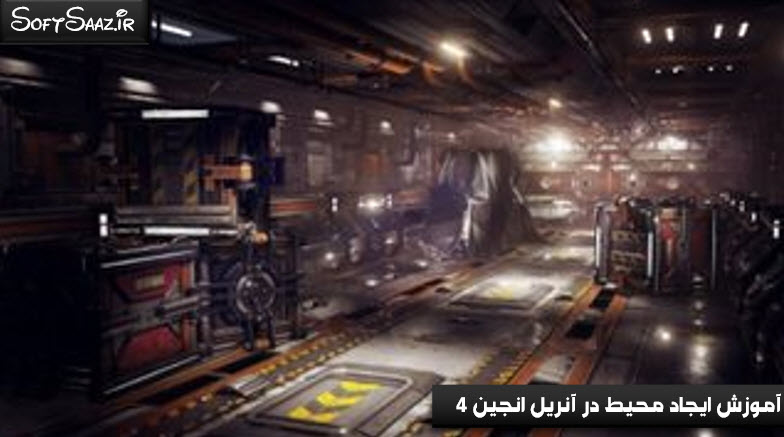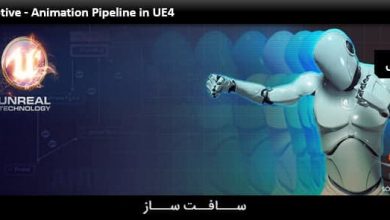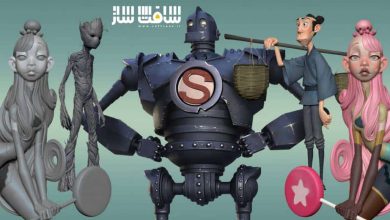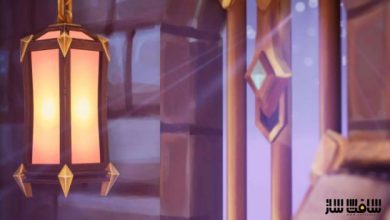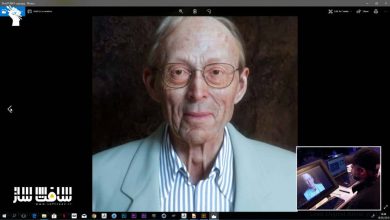آموزش ایجاد محیط در آنریل انجین Unreal Engine 4
Uartsy – Environment Creation in Unreal Engine 4
ایجاد محیط در آنریل انجین
در این دوره آموزشی ” ایجاد محیط در آنریل انجین ” از سایت Uartsy در نرم افزار Unreal Engine ، مربی دوره David Lesperance ، به ایجاد یک محیط واقعی بازی می پردازد.ایجاد یک محیط خیره کننده و به یاد ماندنی با استفاده از تکنیک های بسیار جالب را در این آموزش خواهید دید . با سافت ساز همراه باشید. هر 10 پروژه مجموعه ایجاد محیط در آنریل انجین در واقع یه دوره کامل می باشد.
5 درس مهم دوره ایجاد محیط در آنریل انجین :
- ایجاد asset های سه بعدی برای محیط بازی ویدویی
- تکنیک های مدلسازی و مجسمه سازی پیشرفته
- نحوه تنظیم asset ها و ایجاد یک functioning game world
- نکاتی برای تنظیم حالت و کپچرینگ یک صحنه
- نکات حرفه ایی ، بهترین تمرین ایجاد محیط برای آرتیست ها
این دوره آموزشی شامل 10 پروژه می باشد:
- مبانی مدلسازی برای بازی
- ساخت کیت طراحی ، مدلسازی راهرو ، تنظیم کالیژن
- ایجاد UV در Headus و 3DS Max
- تنظیم نقشه های تکسچر
- مونتاژ UV و ایجاد نقشه نور
- مدلسازی Spline و UV کردن جعبه Sci Fi
- ایجاد پارچه واقعی در Marvelous Designer
- ایجاد Asset کف Tileable
- تکسچرینگ در Quixel Suite و شناخت بهتر نقشه های نور
- ایجاد یک Prop از یک مفهوم (Concept)
دیدن یکی از ویدیو های ایجاد محیط در آنریل انجین :
عنوان دوره : Uartsy – Environment Creation in Unreal Engine 4
سطح : تمام سطوح
زمان کل دوره : 17 ساعت
تعداد فایل های تصویری : 12 پروژه کامل
سال آموزش : 2016
فایل تمرینی : دارد
مربی دوره : David Lesperance
نرم افزار : Quixel Suite , ZBrush , 3DS Max , Marvelous Designer , Unreal Engine
زیرنویس : ندارد
Uartsy – Environment Creation in Unreal Engine 4
Environment artists set the tone for the entire game world and are critical to building games that keep us entranced for hours on end. The best environments immerse us in the story and make us feel like we’re truly part of these fantasy worlds.
In this course from world-renowned artist and favorite ZBW instructor, David Lesperance, you will learn to create those stunning, memorable environments using the very same techniques and programs that the pros use, including Unreal Engine 4.
The 5 most important lessons:
- How to get started creating 3D assets for fully immersive video game environments
- How to take your environment art to a whole new level with advanced modeling and sculpting techniques
- How to set up your 3D environmental assets and create a functioning game world in Unreal Engine 4
- Tips for setting the mood and capturing the feeling of a given scene in your game
- Plus more professional tips and best practices for environment artists working in game production
Project 1 : Basics of Modeling for Games
Lecture 1 07:22 Introduction to Texel Density
Lecture 2 04:23 Introduction to Map Sizes
Lecture 3 04:58 General Guidelines for Enhancing Resolution
Lecture 4 05:09 Texel Density Continued
Lecture 5 09:03 Introduction to Subdivision Modeling
Lecture 6 05:27 Subdivision Modeling Part 2
Lecture 7 02:08 Subdivision Modeling Part 3
Lecture 8 07:19 Modeling with Booleans
Lecture 9 03:43 Spline Modeling
Lecture 10 01:40 What’s Next
Lecture 11 07:04 Basic High-Poly Modeling Part 1
Lecture 12 04:25 Basic High-Poly Modeling Part 2
Lecture 13 14:09 Edge Creasing
Lecture 14 Meet and Greet
Project 2 : Building a Design Kit, Starting the Hallway Model and setting up Collision
Lecture 1 06:51 Blocking In a Hallway Asset
Lecture 2 07:32 Modeling the Level Design Kit Part 1
Lecture 3 07:43 Modeling the Level Design Kit Part 2
Lecture 4 10:13 Modeling the Level Design Kit Part 3
Lecture 5 07:23 Checking Texture Scale
Lecture 6 10:40 Building Low Poly Models
Lecture 7 07:00 Spline Modeling
Lecture 8 10:23 Low Poly Modeling Continued
Lecture 9 05:26 Checking the Model and Breaking Repetition
Lecture 10 17:33 Modeling the Hallway Ceiling
Lecture 11 07:05 Adjusting Scale
Lecture 12 04:27 Checking the Model in Unreal
Lecture 13 03:00 Setting Up Collision Part 1
Lecture 14 03:53 Setting Up Collision Part 2
Project 3 : Creating UV’s in Headus and 3DS Max
Lecture 1 07:50 Introduction
Lecture 2 07:40 Relaxing UVs
Lecture 3 10:43 UVing Part 1
Lecture 4 04:51 UVing Part 2
Lecture 5 09:45 UVing Part 3
Lecture 6 03:51 UVing Part 4
Lecture 7 04:08 UVing Part 5
Lecture 8 04:22 Combining Geo
Lecture 9 04:39 Beginning to Pack UV Islands
Lecture 10 04:48 Continuing to pack UVs
Lecture 11 04:35 Packing More UVs and Tesselating the Object
Lecture 12 06:34 Packing UVs and Baking Normals
Lecture 13 05:20 Using Quixel Suite for Texturing
Lecture 14 06:45 Continuing to Texture and Modeling Pannels
Lecture 15 08:59 Continuing to Model the Pannel
Lecture 16 07:25 Making Desings on the Fly
Project 4 : Tuning Texture Maps
Lecture 1 09:47 Setting up Material Shading Atributes in Unreal4
Lecture 2 07:48 Modeling Interior Bulkheads
Lecture 3 05:56 Creating a Lock Mechanism for Our Hatch
Lecture 4 03:54 Creating Small Assets For the Hatch
Lecture 5 04:50 Continuing to Add to the Hatch Structure
Lecture 6 05:24 Modeling in Detail Pieces
Lecture 7 03:42 Connecting and Positioning Assets
Lecture 8 05:03 Modeling in Engineering Components
Lecture 9 03:53 Adding Detail Quick using Boolians
Lecture 10 05:58 Accurately Positioning Assets into the Scene
Lecture 11 07:07 Implimenting more Structual Details
Lecture 12 06:46 Testing our Assets in Unreal4
Lecture 13 06:56 Creating Detailed Iterations
Lecture 14 06:51 Evaluating Surface Normals
Lecture 15 06:31 Digging Deeper into Surface Normals
Lecture 16 06:09 Stitching, Breaking and cutting UV’s
Lecture 17 03:04 More UVs
Project 5 : Stacking UVs and Creating Light Maps
Lecture 1 05:37 Stacking UVs in UV Layout Part 1
Lecture 2 06:43 Stacking UVs in UV Layout Part 2
Lecture 3 07:31 Offsetting Stacked UVs
Lecture 4 05:07 Ripping Maps Using Xnormals
Lecture 5 03:53 Importance of Stacking
Lecture 6 06:17 Setting up for Texturing
Lecture 7 06:28 Layer Blending Options
Lecture 8 05:40 Cleaning up AO and Map Size Discussion
Lecture 9 07:13 Creating Masks in 3Ds Max
Lecture 10 06:29 Adding Stains
Lecture 11 05:00 Adding Rust
Lecture 12 06:47 Adjusting Values
Lecture 13 07:28 Fixing the Pipe Bottoms
Lecture 14 08:33 Adding More Value Variation
Lecture 15 05:59 Creating a Roughness Mask
Lecture 16 07:52 Plugging in New Maps
Lecture 17 09:41 Setting up Light Maps
Lecture 18 05:48 Trouble Shooting
Project 6 : Spline Modeling and UV’ingThe Sci Fi Crate
Lecture 1 06:58 Creating Game Assets
Lecture 2 03:50 Spline Modeling Game Assets P1
Lecture 3 04:05 Spline Modeling Game Assets P2
Lecture 4 02:50 Detailing Game Assets P1
Lecture 5 03:45 Detailing Game Assets P2
Lecture 6 04:11 Adding Functional Ornate Details P1
Lecture 7 03:04 Adding Functional Ornate Details P2
Lecture 8 05:11 Constructing The Game Asset P1
Lecture 9 03:03 Constructing The Game Asset P2
Lecture 10 07:53 Adjusting Existing and Creating new Handles Hinges and Bolts P1
Lecture 11 02:30 Adjusting Existing and Creating new Handles Hinges and Bolts P2
Lecture 12 05:31 UV’ing the Game Asset P1
Lecture 13 06:16 UV’ing the Game Asset P2
Lecture 14 06:42 Creating Texture Maps For the Game Asset
Project 7 : Creating Realistic Fabric in Marvelous Designer
Lecture 1 06:02 Intro
Lecture 2 06:43 Setting Up the Tarp in Marvelous Designer
Lecture 3 06:02 Bringing the tarp into 3DS Max
Lecture 4 06:44 Modifying the topology of the tarp in 3DS Max
Lecture 5 06:19 Baking Tarp Maps In 3Ds Max
Lecture 6 10:42 Modifying the UV’s of the tarp in 3DS Max
Lecture 7 04:10 Adjusting the Tarp to Fit Over the Crate
Lecture 8 06:34 Creating Texture Maps for the Tarp Part 1
Lecture 9 07:15 Creating Texture Maps for the Tarp Part 2
Lecture 10 05:48 Creating Texture Maps for the Tarp Part 3
Lecture 11 04:37 Bringing the Tarp Into Unreal
Lecture 12 06:23 Creating a Roughness Map for the Tarp
Lecture 13 07:20 Creating a Detail Map for the Tarp
Lecture 14 06:56 Adjusting the Tarp Material in Unreal
Lecture 15 05:42 Modifying the Textures to Work Better in the Scene
Lecture 16 08:47 Adjusting the Scene’s Lighting and Surface Attributes
Lecture 17 12:20 Refining the Tarp’s Edge
Lecture 18 09:55 Modifying Scene Lighting and Assets Maps
Lecture 19 14:03 Reworking the Crate’s Emissive Texture
Lecture 20 09:07 Integrating the Modified Crate and Adjusting the Scene’s Lighting
Lecture 21 12:22 Capturing a Screenshot
Project 8 : Creating a Tileable Floor Asset
Lecture 1 08:45 Introduction and Project Setup
Lecture 2 07:16 Setting Up Zbrush Scene
Lecture 3 04:17 Adding Detail to Tiles
Lecture 4 05:55 Adding Detail to Tiles Part 2
Lecture 5 05:13 Adding Detail to Tiles Part 3
Lecture 6 06:06 Premultiplying and Decimating the Mesh
Lecture 7 06:22 Generating UVs and Adjusting in Max
Lecture 8 05:53 Cleaning Mesh and AO Setup
Lecture 9 05:57 Baking Texture Maps
Lecture 10 06:45 Ripping and Adjusting Maps
Lecture 11 06:06 Applying Normal Map
Lecture 12 05:00 Layering Passes
Lecture 13 06:19 Tweaking UVs and Cavity Pass
Lecture 14 06:05 Adding Color and Texture Variation
Lecture 15 06:25 Detailing with a Color Overlay
Lecture 16 05:51 Bringing the Scene into Unreal
Lecture 17 06:07 Enhancing your Texture Detail
Lecture 18 05:33 Giving Grit to the Tiles
Lecture 19 06:01 Adding Detail with ZBrush
Lecture 20 05:55 Settingup Diffuse Detail and Normal Maps
Lecture 21 06:44 Placing the Tiles in UDK
Lecture 22 05:07 Modifying the Spec Map
Lecture 23 05:55 How to Achieve Photo Real Textures
Lecture 24 05:24 Finalizing the Tiles
Project 9 : Texturing in Quixel Suite and Better Understanding Light Map
Lecture 1 06:29 Understanding Light Maps
Lecture 2 06:09 Fixing Overlapping Uvs
Lecture 3 07:22 Up Resing Light Maps
Lecture 4 05:41 Tweaking Light Map Resolution
Lecture 5 04:58 Unreal Lighting Overview
Lecture 6 03:23 Lighting Summary
Lecture 7 07:47 Saving Out Each Panel
Lecture 8 06:17 Baking out Maps with xNormals
Lecture 9 04:45 Establishing a Base Material In DDO
Lecture 10 04:48 Masking By Material ID
Lecture 11 06:08 PBR Discussion
Lecture 12 06:18 Trouble Shooting DDO
Lecture 13 06:47 Adding More Material Variation
Lecture 14 03:23 Changing Colors
Lecture 15 04:50 DDO Maps Explained
Lecture 16 05:12 AO Discussion
Lecture 17 04:31 Adding Dirt
Lecture 18 04:56 Adjusting Masks
Lecture 19 08:17 Final Material Settings
Project 10 : Creating a Prop From a Concept
Lecture 1 07:08 Calling Out Unique Assets
Lecture 2 05:51 Modeling with Concept Reference
Lecture 3 06:49 Understanding the Workflow
Lecture 4 11:23 Modeling Montage
Lecture 5 06:31 Seeing your Model in a Practicle Sense
Lecture 6 08:26 Knowing your Industry
Lecture 7 09:06 Modeling Montage
Lecture 8 04:53 Rendering and Refining the Model
Lecture 9 04:29 Final Tweaks
Lecture 10 07:11 Introduction to Atlasing
Lecture 11 06:10 Implementing Atlasing
Lecture 12 06:54 Examples of Altasing
Lecture 13 05:26 Furthers Showing the Speed of Atlas Texturing
Lecture 14 10:03 Making an Atlas Texture
حجم کل :
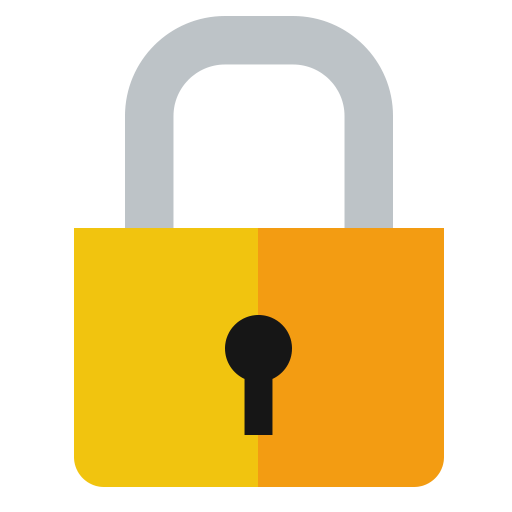
برای دسترسی به کل محتویات سایت عضو ویژه سایت شوید
برای نمایش این مطلب و دسترسی به هزاران مطالب آموزشی نسبت به تهیه اکانت ویژه از لینک زیر اقدام کنید .
دریافت اشتراک ویژه
مزیت های عضویت ویژه :
- دسترسی به همه مطالب سافت ساز
- آپدیت روزانه مطالب سایت از بهترین سایت های سی جی
- ورود نامحدود کاربران از هر دیوایسی
- دسترسی به آموزش نصب کامل پلاگین ها و نرم افزار ها
اگر در تهیه اشتراک ویژه مشکل دارید میتونید از این لینک راهنمایی تهیه اشتراک ویژه رو مطالعه کنید . لینک راهنما
For International user, You can also stay connected with online support. email : info@softsaaz.ir telegram : @SoftSaaz
امتیاز دهی به این مطلب :
امتیاز سافت ساز
لطفا به این مطلب امتیاز دهید ?

